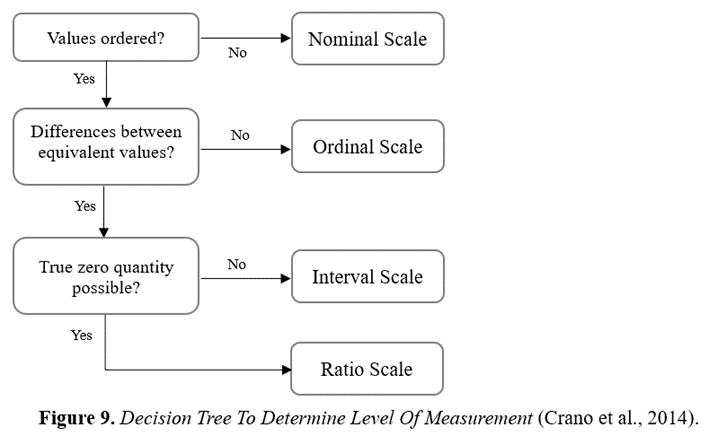Information

Measurement is the process of systematically characterizing or quantifying information about people, events, ideas, or objects of interest. The social sciences have made significant progress in measuring people's underlying beliefs, knowledge, attitudes, and values through scientific scaling approaches and well-designed questionnaires and scales. These tools help researchers access the thoughts and views of respondents and understand the opinions of the person or group under observation. Rating scales are formalized versions of questionnaires that use multiple items to triangulate or help define a concept. Scales are more appropriately used to measure attitudes, values, or personality dispositions because they use multiple items to reflect the view that people's attitudes or beliefs are not singularly defined (Crano et al., 2014; Hair et al., 2021; Leavy, 2022).
Constructing effective questionnaire items applies to scale development as well. Several things to avoid when creating survey questions include double-barrelled questions, double-negative questions, negatively phrased questions, biased or leading questions, questions with built-in assumptions, abbreviations, slang and contractions, ambiguous phrases, and questions that ask respondents to recall information from an unrealistic time frame.
Scale measurement involves assigning a set of scale descriptors to represent the range of possible responses to a question about a particular object or construct. Scale measurement assigns degrees of intensity to the responses, commonly called scale points. There are four basic scale levels: nominal, ordinal, interval, and ratio (Tab. 5).

Nominal scales are the most basic and least powerful scale designs, requiring respondents only to provide some descriptor as the response. Responses do not contain a level of intensity, so ranking the responses is impossible. Nominal scales only allow the researcher to categorize the responses into mutually exclusive subsets that do not have distances between them.
Ordinal scales enable respondents to express relative magnitude between the answers to a question, and responses can be rank ordered in a hierarchical pattern. The researcher can determine relationships between reactions, such as "greater than/less than," "higher than/lower than", "more often/less often," "more important/less important," or "more favourable/less favourable." Mathematical calculations with ordinal scales include mode, median, frequency distributions, and ranges but cannot determine the absolute difference between rankings.
Interval scales can measure the absolute difference between scale points. The intervals between scale numbers tell us how far apart the measured objects are on a particular attribute. This approach enables us to compare different levels of any attribute. Beyond the mode and median, researchers can calculate the mean and standard deviation of respondents' responses for interval scales. Researchers can report findings not only about hierarchical differences (better than or worse than) but also the absolute differences between the data.
Ratio scales are the highest-level scale because they enable the researcher to identify the absolute differences between each scale point and make absolute comparisons between the responses. Ratio scales are designed to enable a "true natural zero" or "true state of nothing" response to be a valid response to a question. Generally, ratio scales ask respondents to provide a specific numerical value as their response, regardless of whether a set of scale points is used. In addition to the mode, median, mean, and standard deviation, one can compare levels.
It is crucial to consider the nature of the variables being studied when selecting the appropriate level of measurement for research. Figure 9 provides a helpful guide for researchers to determine the measurement level most suitable for their particular study. By carefully considering the characteristics of the variables at hand, researchers can ensure that their data is accurately and appropriately measured, leading to more valid and reliable findings.
